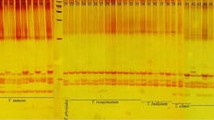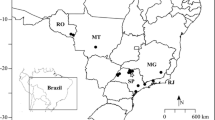Abstract
Byrsonima Rich. is one of the largest genera of the Malpighiaceae family with 97 species occurrence in Brazil and multiple potentialities, including pharmaceutical and food industries. In this study, 17 microsatellite markers characterized in Byrsonima cydoniifolia were tested for seven related taxa, all species are native to Brazil and four are endemic. Genomic DNA was extracted from leaves tissues and 17 microsatellite markers were used to cross-amplification of microsatellite regions. Polymorphism and genetic diversity were evaluated for B. intermedia, B. verbascifolia, B. laxiflora, B. subterranea, B. umbellata, B. linearifolia. from 16 individuals and for B. viminifolia from 14 individuals. Transferred microsatellite markers panels ranged from 11 (64.8%) in B. viminifolia to 6 (35.2%) in B. umbellata. The total number of alleles per locus ranged from 5 (B. linearifolia) to 8 (B. subterranea) alleles. B. umbellata showed lower values of observed and expected heterozygosity (HO = 0.312; HE = 0.436) and B. subterranea presented the highest values (HO = 0.687; HE = 0.778). A greater number of microsatellite markers should be developed for B. umbellata. The microsatellite marker panels transferred to the species B. intermedia, B. verbascifolia, B. laxiflora, B. subterranea, B. viminifolia and B. linearifolia are very informative, with a high combined probability of exclusion of paternity (Q ≥ 0.976) and the low combined probability of identity (I ≤ 9.91 × 10–6), potentially suitable for future genetic-population studies, supporting strategies for maintaining the genetic diversity and for exploration of Byrsonima species as genetic resources.
Similar content being viewed by others
References
Mamede MCH, Amorim AM, Sebastiani R, Almeida RF et al (2015) Malpighiaceae. Lista de Espécies da Flora do Brasil. Jardim Botânico do Rio de Janeiro. http://floradobrasil.jbrj.gov.br/jabot/floradobrasil/FB155
de Souza VR, Aniceto A, Abreu JP, Montenegro J, Boquimpani B, de Jesuz VA, Teodoro AJ (2020) Fruit-based drink sensory, physicochemical, and antioxidant properties in the Amazon region: Murici (Byrsonima crassifolia (L.) Kunth and verbascifolia (L.) DC) and tapereba (Spondia mombin). Food Sci Nutr 8(5):2341–2347. https://doi.org/10.1002/fsn3.1520
Vieira RF, Agostini-Costa TDS, Silva DD, Sano SM, Ferreira FR (2010) Frutas nativas da região centro-oeste do Brasil. Embrapa Informação Tecnológica, Brasília
Almeida MMB, de Sousa PHM, Arriaga ÂMC, do Prado GM et al (2011) Bioactive compounds and antioxidant activity of fresh exotic fruits from northeastern Brazil. Food Res Int 44(7):2155–2159. https://doi.org/10.1016/j.foodres.2011.03.051
Arakaki DG, dos Samúdio Santos V, Melo EPD, Pereira H, SilvaFigueiredo P, Rodrigues Cortês M, do Aragão Nascimento V (2020) Canjiqueira fruit: Are we losing the best of it? Foods 9(4):521. https://doi.org/10.3390/foods9040521
Santos JFL, Rossi AAB, Pena GF, Tiago AV, Zortéa KEM, Cardoso ES, Santos IRB (2020) Variability of fruits and seeds of Byrsonima crassifolia (Malpighiaceae) genotypes cultivated in northern Mato Grosso State, Brazil. Genet Mol Res. https://doi.org/10.4238/gmr18620
de Souza VR, Pereira PAP, Queiroz F, Borges SV et al (2012) Determination of bioactive compounds, antioxidant activity and chemical composition of Cerrado Brazilian fruits. Food Chem 134(1):381–386. https://doi.org/10.1016/j.foodchem.2012.02.191
Vasconcelos NG, Vaz MSM, Radai JAS, Kassuya CAL, Formagio ASN, Graciani FS, Simionatto S (2020) Antimicrobial activity of plant extracts against carbapenem-producing Klebsiella pneumoniae and in vivo toxicological assessment. J Toxicol Environ Health A 83(23–24):719–729. https://doi.org/10.1080/15287394.2020.1824135
Semagn K, Bjørnstad Å, Ndjiondjop MN (2006) An overview of molecular marker methods for plants. Afr J Biotech 5(25):2540–2568
Riaz A, Anjum MA, Naz S, Balal RM (2021) Applications of molecular markers in fruit crops for breeding programs—a review. Phyton 90(1):17. https://doi.org/10.32604/phyton.2020.011680
Barbara T, Palma-Silva C, Paggi GM, Bered F et al (2007) Cross-species transfer of nuclear microsatellite markers: potential and limitations. Mol Ecol 16(18):3759–3767. https://doi.org/10.1111/j.1365-294X.2007.03439.x
Vinson CC, Mangaravite E, Sebbenn AM, Lander TA (2018) Using molecular markers to investigate genetic diversity, mating system and gene flow of Neotropical trees. Braz J Bot 41(2):481–496. https://doi.org/10.1007/s40415-018-0472-x
Bernardes V, dos Anjos DE, Gondim SGDCA, Murakami DM, Bizão N et al (2014) Isolation and characterization of microsatellite loci in Byrsonima cydoniifolia (Malpighiaceae) and cross-amplification in B. crassifolia. Appl Plant Sci 2(5):1400016. https://doi.org/10.3732/apps.1400016
Doyle JJ, Doyle L (1987) A rapid DNA isolation procedure for small quantities of fresh leaf tissue. Phytochem Bull 19:11–15
Paetkau D, Calvert W, Stirling I, Strobeck C (1995) Microsatellite analysis of population structure in Canadian polar bears. Mol Ecol 4(3):347–354. https://doi.org/10.1111/j.1365-294X.1995.tb00227.x
Wagner HW, Sefc KM (1999) IDENTITY 1.0. Centre for applied genetics. University of Agricultural Sciences, Vienna, p 500
Goudet J (2002) FSTAT is a computer package for PCs which estimates and tests gene diversities and differentiation statistics from codominant genetic markers (version 2.9.3). University of Lausanne, Department of Ecology and Evolution, Lausanne
Moe KT, Gwag JG, Park Y (2012) Efficiency of powercore in core set development using amplified fragment length polymorphic markers in mungbean. Plant Breed 131(1):110–117. https://doi.org/10.1111/j.1439-0523.2011.01896.x
Salanti G, Amountza G, Ntzani EE, Ioannidis JP (2005) Hardy-Weinberg equilibrium in genetic association studies: an empirical evaluation of reporting, deviations, and power. Eur J Hum Genet 13(7):840–848. https://doi.org/10.1038/sj.ejhg.5201410
Vieira MLC, Santini L, Diniz AL, Munhoz CDF (2016) Microsatellite markers: what they mean and why they are so useful. Genet Mol Biol 39(3):312–328. https://doi.org/10.1590/1678-4685-GMB-2016-0027
Brondani RPV, Gaiotto FA, Missiaggia AA, Kirst M et al (2003) Microsatellite markers for Ceiba pentandra (Bombacaceae), an endangered tree species of the Amazon forest. Mol Ecol Notes 3(2):177–179. https://doi.org/10.1046/j.1471-8286.2003.00389.x
Schmidt AB, Ciampi AY, Guerra MP, Nodari RO (2007) Isolation and characterization of microsatellite markers for Araucaria angustifolia (Araucariaceae). Mol Ecol Notes 7(2):340–342. https://doi.org/10.1111/j.1471-8286.2006.01602.x
de Campos Vaz AR, de Oliveira Borba TC, Brondani C, Rangel PHN et al (2009) Genetic analysis of a local population of Oryza glumaepatula using SSR markers: implications for management and conservation programs. Genetica 137(2):221–231. https://doi.org/10.1007/s10709-009-9393-8
Ciampi AY, Azevedo VCR, Gaiotto FA, Ramos ACS et al (2008) Isolation and characterization of microsatellite loci for Hymenaea courbaril and transferability to Hymenaea stigonocarpa, two tropical timber species. Mol Ecol Resour 8(5):1074–1077. https://doi.org/10.1111/j.1755-0998.2008.02159.x
Telles MPC, Peixoto FP, Lima JDS, Resende LV et al (2011) Development of microsatellite markers for the endangered Neotropical tree species Tibouchina papyrus (Melastomataceae). Genet Mol Res 10(1):321–325. https://doi.org/10.4238/vol10-1gmr1026
Telles MPC, Silva JB, Resende LV, Vianello RP et al (2013) Development and characterization of new microsatellites for Eugenia dysenterica DC (Myrtaceae). Genet Mol Res 12(3):3124–3127. https://doi.org/10.4238/2013
Guimarães RA, Miranda KMC, Chaves LJ, Naves RV et al (2019) Mating system and pollen dispersal in Dipteryx alata Vogel (Leguminosae): comparing in situ and ex situ conditions. Tree Genet Genomes 15(2):28. https://doi.org/10.1007/s11295-019-1337-6
Gonçalves AR, Chaves LJ, Telles MPC (2019) Genetic variability and effective population size in Hymenaea stigonocarpa (Fabaceae) germplasm collection: tools for breeding programs and genetic conservation. Genetica 147(5):359–368. https://doi.org/10.1007/s10709-019-00076-0
Miranda KMC, Guimarães RA, Silva MJD, Oliveira PRO, Ribeiro TG, Mendes TP, Soares TN (2020) Cross-amplification and characterization of microsatellite markers in species of Manihot Mill. (Euphorbiaceae) endemic to the Brazilian cerrado. Acta Bot Bras 34(4):772–777. https://doi.org/10.1590/0102-33062019abb0374
Croft GK, Schaal BA (2012) Development of microsatellite markers in Byrsonima crassifolia (Malpighiaceae). Am J Bot 99(3):e111–e113. https://doi.org/10.3732/ajb.1100457
Menezes APA, Enoque MM, Resende-Moreira LC, Lovato MB (2014) Cross-amplification of microsatellite markers developed for Byrsonima crassifolia (L.) Kunth (Malpighiaceae) in other congeneric species. In: XI Congresso Latinoamericano de Botanica e 65 Congresso Nacional de Botanica, Salvador. Anais do 65 Congresso Nacional de Botanica. https://doi.org/10.13140/2.1.2455.2649
Santos-Zanuncio VS, Alves FM, Silva DB, Carollo CA (2021) Chemosystematic implications based on metabolic profiling of the genus Byrsonima (Malpighiaceae). Folia Geobot 55:289–300. https://doi.org/10.1007/s12224-020-09381-5
Francener A (2016) Estudos taxonômicos em Byrsonima sect. Eriolepsis Nied. (Malpighiaceae) Tese 184f. Instituto de Botânica, São Paulo
Santos JVDC, Oliveira MDFVD, Santos Filho FS, Silva LNNDS, Araújo JS (2020) The taxonomic value of leaf anatomy for species Byrsonima: a difficult genus of Malpighiaceae Juss. Acta Bot Bras 34(3):570–579. https://doi.org/10.1590/0102-33062020abb0144
Menezes AP, Resende-Moreira LC, Buzatti RS, Nazareno AG, Carlsen M, Lobo FP, Lovato MB (2018) Chloroplast genomes of Byrsonima species (Malpighiaceae): comparative analysis and screening of high divergence sequences. Sci Rep 8(1):1–12. https://doi.org/10.1038/s41598-018-20189-4
Garrido-Cardenas JA, Mesa-Valle C, Manzano-Agugliaro F (2018) Trends in plant research using molecular markers. Planta 247(3):543–557. https://doi.org/10.1007/s00425-017-2829-y
Acknowledgements
This work was supported by a PRONEX project from: PRONEX—FAPEG/CNPq (CP 07/2012). We would like to thank the reviewers for all the suggestions and the consequent improvement of our manuscript. The Coordination for the Improvement of Higher Education Personnel (CAPES) for the doctoral scholarship and the National Council for Scientific. M.P.C.T. have been continuously supported by productivity fellowships from Conselho Nacional de Desenvolvimento Científico e Tecnológico (CNPq). Our current research in Genetics and Genomics is developed in the context of National Institutes for Science and Technology (INCT) in Ecology, Evolution and Biodiversity Conservation, supported by MCTIC/CNPq (Proc. 465610/2014-5) and Fundação de Amparo à Pesquisa do Estado de Goiás (FAPEG), which we gratefully acknowledge.
Funding
Work by V. Bernardes was supported by a fellowship from CAPES, and work by M. P. C. Telles, was also supported by productivity grants from CNPq. This study was partially supported by a Programa de Apoio a Núcleos de Excelência (PRONEX) grant from CNPq/FAPEG (AUX PESQ CH 007/2009) and by grants to the research network GENPAC (Geographical Genetics and Regional Planning for natural resources in Brazilian Cerrado) from CNPq/FAPEG (Project No. 201110267000125 and 563839/ 2010-4–563973/2010-2). Our current research in Genetics and Genomics is developed in the context of National Institutes for Science and Technology (INCT) in Ecology, Evolution and Biodiversity Conservation, supported by MCTIC/CNpq (Proc. 465610/2014-5) and FAPEG.
Author information
Authors and Affiliations
Contributions
DMM, NB, MJS; Marcos José provided the plant material. MPCT, DMM and NB conceived the idea and provide necessary resources. VB and TNS designed the experiments, mined the data and perform the experiments. VB and MPCT wrote the manuscript. All authors have read and approved the final manuscript.
Corresponding author
Ethics declarations
Conflict of interest
The authors declare no conflict of interest.
Ethical approval
This article does not contain any studies with human participants or animal.
Additional information
Publisher's Note
Springer Nature remains neutral with regard to jurisdictional claims in published maps and institutional affiliations.
Supplementary Information
Below is the link to the electronic supplementary material.
Rights and permissions
About this article
Cite this article
Bernardes, V., Murakami, D.M., Bizão, N. et al. Transferability and characterization of microsatellite markers from Byrsonima cydoniifolia A. Juss. (MALPIGHIACEAE) in seven related taxa from Cerrado biome reveal genetic relationships. Mol Biol Rep 48, 4039–4046 (2021). https://doi.org/10.1007/s11033-021-06411-z
Received:
Accepted:
Published:
Issue Date:
DOI: https://doi.org/10.1007/s11033-021-06411-z




